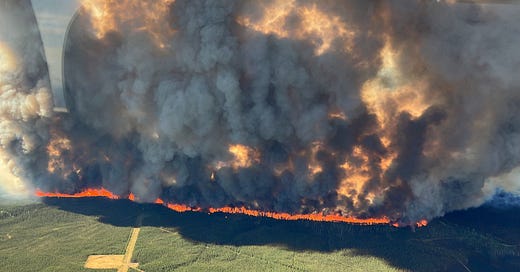Better management, preparation can prevent wildfires
Fires are continuing to rage throughout British Columbia, devastating farmland, and forests, even though it’s September and cooler weather should soon be upon us.
Peace River North MLA Dan Davies believes that a large part of the responsibility for these fires lies in bad forest management practices.
“Climates change, there has been changes, but we need to be looking at managing our forests differently,” Davies said. “We need to be cleaning up our forests, cleaning them up properly and looking at how can make sure our forests are there for future generations.”
AgSafe BC safety consultant Reg Steward feels that lack of preparation is the problem. He says that if the half amount of money that is spent on fighting fires is put into prevention, it would go a long way to reducing the number of wildfires.
“We need to be awake and aware of the resources available for prevention and preparation,” Steward said at meeting with local farmers earlier this summer. “We need to understand the value of working together.”
Creating an inventory of resources and sharing those resources is key to getting ahead of fires when they happen, as is understanding the value of working together. There are a lot of stories out there of farmers and ranchers being prevented from assisting with fighting the fires that threatened their properties and that of their neighbours.
Currently, BC has what Steward calls a self-defeating system, in that the government was not letting people with CATs and water trucks help to save their own homes.
“Twenty-five years of CAT or fire fighting experience doesn’t count because they’re not CORE certified.”
“Why can’t they use the red shirts for supervising people who live there? Two red shirts could supervise ten guys. Do we need 24 guys from New Zealand?”
“The community needs to be allowed to take responsibility,” said Steward. Being prepared, having a community plan in the event of a fire, flood or evacuation, a plan that makes that makes sense will help mitigate many of the problems that farmers and ranchers have faced this year.
“It boggles the mind that we have 24 fire fighters come from New Zealand and Mexico,” Steward said. “Talk to the young people and get them to take the S100 course and train them in initial attack.”
By changing the thinking, Steward says, and spending more in preparation and mitigation will lead to less spending in response to events.
“There needs to be something we can do on a provincial and national scale. We need to build a way to put the money in the before.”
For example, Steward says that in 2019 the provincial government saved money on fire fighting but didn’t put those savings into preparation. They spent it instead. When it could’ve been used for preparedness.
Communities need a plan and a methodology, Steward said, a militia mentality that says we’re all in this together. An attitude of inclusion, asking what people can do and finding a role for those people who want to help, should be part of the planning process in calm days, part of the preparedness.
“What if we had a system where every rancher and ten untrained people being told to spray here, dig there? Our greatest assets might be the people on the ground, in the community, not the professional.”
“You never hear about big fires in Texas. Why? Because the state has returned fire prevention to the landholders. The take care of the deadfall,” said Steward.
Leaving partially burnt trees just provides more fuel for the next fire, as when a fire burns hot and fast, it doesn’t burn the entire tree. What’s left is dead stands of blackened trees with burnt bark on the outside and normal looking wood on the inside. A lot of this timber is salvageable.
There needs to be better “cleaning up when there’s been a big burn, like at Donnie Creek. There’s a ton of burned timber there that still has value, but they’re just left,” Davies said.
Davies added that although the burned trees are dead, the fibre is still good, for about 18 months after a forest fire goes through.
Canfor says it does use salvaged timber from the Fort St. John TSA, once it has been determined whether it’s viable for processing. The bulk would go to sawmills first, with the residue being used in pulp mills and pellet plants. With the closing of Canfor’s Taylor pulp mill, the residue from the TSA would likely be destined for the Fort St. John pellet plant. Although the primary species harvested by Canfor for timber are softwoods – Lodgepole Pine, White Spruce and Sub-Alpine Fir – all species, including aspen and birch can be used in pellet plants.
“We’re short fibre in BC right now, we’re seeing pulp mills close, lumber mills close, pellet plants are struggling to get fibre," he said. “But the province of British Columbia, under the NDP, are just choosing to leave it and let nature run it’s course.”



